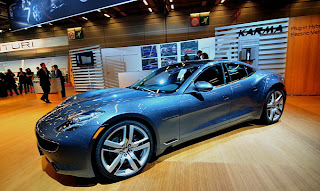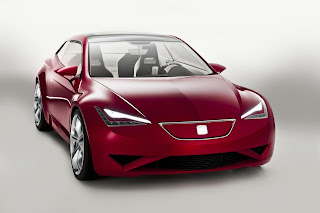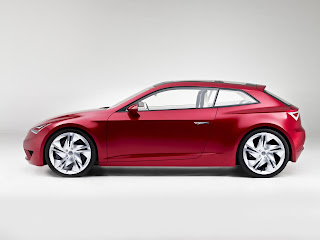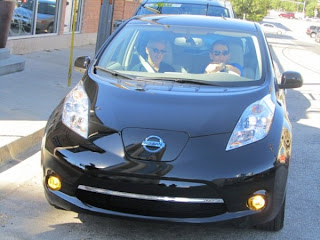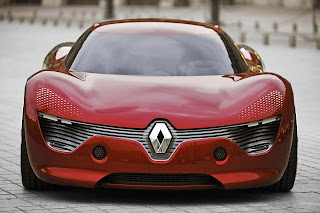Blog Archive
-
▼
2010
(3291)
-
▼
September
(319)
- Fisker debut production Karma Hybrid Paris 2010
- Boeing SolarEagle UAV can stay aloft for five years
- Seat unveil IBE Electric Concept
- 2015 Lotus Eterne AWD hybrid sedan concept
- Toshiba To Develop EV Batteries With Fiat Scania
- LG Chem to Supply Li-ion Batteries to Renault for EVs
- Lance Armstrong Takes Delivery of the First Nissan...
- SsangYong Korando platform to underpin two new models
- Renault Concept DeZir debuts in Paris
- Audi e-tron twin-turbo V6 Diesel Electric Hybrid S...
- Delphi working with WiTricity on wireless car charger
- 2010 SEMA Show: Hyundai Sonata 2.0T by RIDES
- Paris Auto Show: 2012 Ford Focus ST
- Electric Opel Meriva Joins MeRegioMobil E-Mobility...
- Jaguar C-X75 AWD Wheel Motor Powered Electric Supe...
- Skoda Octavia EV concept car
- Fiat 500 to retain its shape for next refresh
- 2011 Lamborghini Super Sport Cars Lamborghini Gall...
- 2011 Lamborghini Super Sport Cars Lamborghini Gall...
- 2011 Lamborghini Super Sport Cars Lamborghini Gall...
- 2010 KIA Forte Koup SX
- land rover discovery cars
- land rover lr4 wallpapers
- Volvo C30 Electric - Battery Crash Test
- Mitsubishi to Co-develop EV Peugeot Partner and Ci...
- A link between air travel and deaths on the ground
- Skoda Octavia Green E Line Concept
- 2011 Chevrolet Volt could receive 25% electric ran...
- Exagon Furtive eGT EV concept debut in Paris
- UK's shipping emissions six times higher than expe...
- 2011 Honda Jazz Hybrid due for Paris Motor Show debut
- 2011 Volkswagen Touareg - Released in USA
- Volkswagen Golf R by Wimmer
- Lotus Elite Supercar may Feature Toyota Sourced Hy...
- 2012 Maserati Sport Cars GranTurismo MC Stradale
- 2012 Maserati Sport Cars GranTurismo MC Stradale
- 2012 Maserati Sport Cars GranTurismo MC Stradale
- Lexus LFA Supercar
- Montreal Auto Show: Locus Plethore supercar unveil...
- Supercar trio show future's bright
- Details Emerge on Jaguar's new 200mph Supercar
- Green GT’s All-Electric Supercar Unveiled
- Mercedes Planning Audi R8 Killer
- BMW supercar concept pays Homage to M1.
- Mini's Wheel Motor Powered Scooter E Concept
- Mitsubishi Motors and LG Chem to Develop EV Battery
- Global wind energy capacity nears 200GW
- Peugeot Sport Cars Epine Concept Cars Inspired by ...
- Peugeot Sport Cars Epine Concept Cars Inspired by ...
- New Renault Truck Racing Video Game
- Lamborghini Gallardo LP570-4 Blancpain Edition
- Sketch: 2013 Infiniti EV
- BMW announce 1 Series based ActiveE electric car u...
- Renault plans affordable rear-wheel-drive sports car
- Photo Gallery: 2011 Mercedes Viano/Vito facelift
- Chevy Cars
- Luxury Car Modifications
- Spyker Car Modification│2010 Trend Modification
- New Cars 2011 Porsche 911 Carrera GTS
- Tomorrow's Volvo: body panels serve as the car bat...
- Mini rejects the idea of British design studio (UK)
- 2011 Nissan Micra platform to underpin sedan and s...
- Audi could sell 10,000 more cars (UK)
- News in brief
- Toyota to build Yaris Hybrid in France from 2012 (...
- SEMA Show: ARK Hyundai Genesis Coupe
- Jay Leno's Garage Takes the Tesla Roadster 2.5 For...
- 20,000 U.S. Nissan Leaf Pre-Orders taken, First ph...
- Infiniti Releases Sketch of Future Luxury Hybrid V...
- Subaru to launch Impreza WRX STI saloon in Britain...
- Preview: 2011 KTM X-Bow R
- Renault Kangoo Express Z.E. will go in serial prod...
- 2010 Lotus Sports Cars Elite Concept Cars
- 2010 Lotus Sports Cars Elite Concept Cars
- Renault launches Kangoo Van ZE in UK
- GM/Opel Unveil Voltec Cargo Van Series Hybrid Conc...
- Exotic Concept Cars
- porsche cayman wallpapers
- hyundai santa fe wallpaper
- 2011 Ferrari SA Aperta
- Chrysler suspends several employees for disobedien...
- Cadillac recalls 2009 - '10 CTS AWD and CTS-V (U.S)
- Toyota Leads The Way in 2010 Motorist Choice Awards
- Toyota to mass produce plug-in electric vehicle fo...
- World’s largest offshore wind farm starts producin...
- Congressman ‘outraged' by report China seeks EV te...
- 2011 Peugeot 408
- 2011 Toyota Highlander Pricing
- Paris Preview: Mini Scooter E Concept
- Audi R8 GT New Photos and Pricing
- Peugeot claim 6 Acceleration World Records with th...
- 2010 Caterham Sport Cars Seven Roadsport 125 Monaco
- 2010 Caterham Sport Cars Seven Roadsport 125 Monaco
- Paper Li-ion Batteries Offer Flexible Power Options
- 2010 Toyota Corolla Sport
- Ford Transit Connect Electric Launches At the 2010...
- Aston Martin One-77 will receive the most powerful...
- Ford Fiesta ST: the first sight
- Car V Bike Citroën Survolt Electric Car Versus Agn...
- 2011 Volvo S60 All New
-
▼
September
(319)
Fisker debut production Karma Hybrid Paris 2010
Anticipation and excitement has grown at Fisker Automotive and with the general public wanting to see the production Karma. Today, Fisker Automotive unveiled the first factory built luxury plug-in Karma at the Paris Motor Show.
“This vehicle represents our goal of bringing an eco-friendly vehicle founded on the principals of ‘Pure Driving Passion’ to consumers around the world,” said CEO Henrik Fisker.
The message has always been clear - designing a beautiful vehicle utilizing
innovative technology provides freedom to the driver, versus containment - fusing
green technology with energy independence. It also involves an unwavering
commitment to purity. When sourcing environmentally conscious and sustainable
materials, if Fisker designers and engineers felt the existing technologies did not
meet their exacting standards, they developed new, superior approaches that have
resulted in several proprietary designs.
One of these unique technologies is the world’s largest continuous solar panel roof
for an automobile. This beautiful, sculptural form captures the power of the sun to
help power the Karma.
The pursuit of pure design also led Fisker to create one of the most sustainable and accountable interiors in automotive history.
To process the leather for the Karma’s interior a 100% sustainable manufacturing
strategy is used, resulting in one of the highest yields in the industry. This process is conducted at the world’s first energy self-sufficient, closed loop leather manufacturing plant where both gas and electricity are generated on-site from by-products of the leather making process.
The Karma’s interior wood wings and accents are also unique and sustainable -
sourced from certified fallen, sunken and rescued wood to create a luxurious sensory experience inspired by nature.
Fisker Automotive’s commitment to purity throughout the Karma reflects its
dedication to introducing sustainability and accountability to luxury automotive design - Responsible Luxury.
To date, Fisker Automotive has nearly 70 patents and patents pending for the Karma
- a very good reason to have kept the Karma’s technical detail under wraps.
From Concept to Reality, Unchanged
Designed by Fisker Automotive co-founder, CEO and executive design director
Henrik Fisker, the four-door, four-passenger Karma combines world-class style with
better efficiency and lower emissions than today’s best hybrids to deliver an
uncompromised, premium vehicle that sets the tone for the future of driving. Mr.
Fisker is responsible for designing some of the most desirable and iconic luxury
sports cars of the modern era, including the Aston Martin V8 Vantage, Aston Martin
DB9, BMW Z8 and Artega GT.
With exotic car looks, sports car performance, an achievable annual average
economy of 2.4L/100 km (100 mpg) and emissions of just 83g/km, the 300 kW (403
hp/408 PS) Fisker Karma is the only truly responsible alternative to traditionally
powered luxury cars.
True to Fisker’s goal of bringing the Karma concept to reality in its original form, the production car retains, and even adds to, all of the original concept’s elegant design, dramatic proportion and unique features.
“Too often concept cars are just that – concepts,” Henrik Fisker said. “As car
enthusiasts we wanted to see all that excitement and imagination make it to
production. It’s what keeps us in love with cars. I feel our team has succeeded in
every way.”
Most notable is the Karma’s athletic appearance. At 4.99 meters (196.7 in) long, 1.98 meters (78.1 in) wide and just 1.33 meters (52.4 in) high, the Karma’s final
dimensions remain virtually the same as the concept’s.
A long hood -- accentuated by a large dash-to-axle ratio -- and short deck give the
Karma a timeless silhouette. Its expansive (3.16 m/124.4 in) wheelbase, short
(913/923 mm - 35.9/36.3 in f/r) overhangs and wide (1.69/1.70 m - 66.6/67.0 in f/r)
track reinforce the Karma’s performance orientation even when standing still.
Also retained from the concept are the 22-inch aluminum-alloy ‘Circuit Blade’ wheels and the world’s largest spherically curved, monolithic solar roof panel, which communicate the car’s advanced technology and environmental purpose. The Fisker Karma is the first car to be equipped with 22-inch wheels as standard equipment.
In addition, the production Karma keeps the concept’s complex parting lines around
front and rear fascias, along with the industry’s tightest tire-to-wheel arch
relationship. These details enhance the Karma’s overall design and set it further
apart from its competitors.
The most significant visible exterior change is the addition of B-pillars, which increase the Karma’s structural rigidity and help it meet global crash protection requirements.
Unique to the segment is the Karma’s absence of external window frames between
rear door-glass panes, which improves aesthetics and reduces wind noise.
While the Karma Command Center™ -- the industry’s first and, at 25 cm (10.2 in),
largest haptic feedback touch screen – elegantly consolidates into a single location controls for automatic dual-zone climate, audio/infotainment, phone, navigation and vehicle systems.
Like the concept, the production Karma has a four-seat cockpit with a large center
console running from the dashboard to the rear seatback, which houses the
rechargeable Lithium ion battery.
This console incorporates intuitive gear selector buttons in place of the original
shifter, as well as electric window controls, seat heater switches, storage and four cup holders.
Advanced Technology Plug-in Hybrid Power
Under the skin, Fisker’s exclusive Q-Drive® plug-in hybrid electric powertrain
technology combines world class performance with industry-leading economy and
the lowest emissions.
With 300 kW of power and more than 1,300 Nm (981 lb-ft) of torque at zero rpm the
electrically-driven Fisker Karma can quickly reach Autobahn speeds, yet achieve
better annual average fuel economy and lower CO2 emissions than nearly any other
production car.
Karma drivers will not be concerned about Range Anxiety. By leveraging the world’s
existing gasoline infrastructure, the Fisker Karma has a total range of 480 km (300
mi).
Eighty kilometers (50 mi) are electric-only and tailpipe-emission free when powered
only by its 20 kWh Lithium ion battery, which can be recharged in as little as six
hours on standard 240-volt current.
When the battery is depleted, or when the driver engages Sport mode, the Karma’s
2.0L, turbocharged four-cylinder Ecotec® gas engine automatically turns a 175 kW
generator that sends electricity to two 150 kW (201.5 hp/204 PS) electric traction
motors mounted directly to the rear differential.
This single speed gearbox ensures a smooth, constant delivery of power to the
wheels without hesitation, all the way to the Karma’s top speed of 200 kmh (125
mph).
World Class Manufacturing
While Fisker Automotive is globally headquartered in Southern California, the Karma
will be built by Valmet Automotive at its state-of-the-art flexible assembly plant in Finland.
Fisker partnered with Valmet because the 41-year-old company was able to meet
Fisker’s strict requirements of cost-effectively building 15,000 high quality, advanced technology vehicles per year for international markets.
Since 1969 Valmet has built more than 1.1 million vehicles for demanding customers
all over the world, and currently builds Porsche Boxster and Porsche Cayman sports
cars for Porsche AG.
The Fisker Karma is the world’s first premium plug in hybrid and the embodiment of
the design-driven company’s firm belief that environmentally conscious cars need not sacrifice passion, style or performance.
.
Boeing SolarEagle UAV can stay aloft for five years
Boeing's solar/electric-powered high altitude long endurance unmanned aerial vehicle, SolarEagle, has clinched a $89 million deal with the US Defense Advanced Research Projects Agency (DARPA) to develop and fly the unmanned aircraft capable of staying aloft for up to five years.
"SolarEagle is a uniquely configured, large unmanned aircraft designed to eventually remain on station at stratospheric altitudes for at least five years," explained Boeing spokesperson Pat O'Neil.
"that's a daunting task, but we have a highly reliable solar-electric design that will meet the challenge in order to perform persistent communications, intelligence, surveillance and reconnaissance missions from altitudes above 60,000 feet."
According to O'Neil, the SolarEagle demonstrator is slated to remain in the upper atmosphere for 30 days during testing - harvesting solar energy that will be stored in fuel cells and used to power the aircraft at night.
The unmanned aircraft will also boast highly efficient electric motors and propellers, along with a high-aspect-ratio, 400-foot wing for increased solar power and aerodynamic performance.
O'Neil noted that the SolarEagle was only one of Boeing's rapid prototyping projects.
"efforts include the Phantom Ray, a fighter-sized, unmanned, advanced technology demonstrator scheduled to make its first flight in early 2011.
"The hydrogen-powered Phantom Eye demonstrator, a High Altitude Long Endurance aircraft designed to stay aloft for up to four days, also scheduled to make its first flight in 2011."
The SolarEagle is expected to make its first demonstration flight in 2014.
.
Seat unveil IBE Electric Concept
SEAT is presenting at the 2010 Paris Motor Show its clear vision of a super-compact sports coupé for the urban mobility of the near future. The first version of the SEAT IBE was already presented in Geneva; since then its design, technology and interior have been further developed. Now on show is its interior, which is incredibly spacious and versatile for this vehicle format, as well as an innovative concept for individualised connectivity and infotainment.
Driving fun and dynamics are at the forefront with the SEAT IBE, as is clearly evident with just one look at the red paintwork of the concept car. The little sports car is low and wide, with powerful proportions and a concentrated gaze delivered by the razor-sharp lines of its LED headlamps. With its short body length of only 3.83 meters, it is the ideal fit for the urban mobility of the young and young at heart. And the SEAT IBE combines perfectly its sports car character with innovative technology. The all-electric drive facilitates local zero-emissions driving fun, while the powerful motor with 75 kW (102 hp) and the low weight delivered by intelligent mixed-material construction guarantee refined performance.
Alongside the technical concept, the design of the SEAT IBE also points to an exciting future. Its athletic styling and clear, precise lines indicate the next evolutionary step in the SEAT design DNA. Style elements with unmistakable character - reduced to the minimum but perfectly executed – demonstrate the strategic quality of SEAT design in the development of future model generations.
“SEAT is working very hard on future electro-mobility,” stresses James Muir, President of SEAT, S.A. “Following the great success of our highly efficient ECOMOTIVE models, hybrids and electric vehicles are further steps in our clear corporate strategy. And the IBE leaves no room for doubt – the future will find SEAT offering the most innovative, bold and youthful cars in their respective segments, without sacrificing anything in terms of usability.”
Concept: Dynamic driving fun with ecological responsibility
The SEAT IBE takes a unique approach to combining dynamic design and compact sporting character with incredible usability. It is conceived for the urban conurbations of Europe, like Paris, London, Berlin or Barcelona. Here is where the IBE will come into its own with zero-emissions driving fun, exceptional manoeuvrability, an impressive amount of space – and, of course, with a cool look courtesy of its clear and extroverted design language.
“Zero-emissions mobility in urban areas is becoming increasingly important,” says Frank Bekemeier, Executive Vice-President for SEAT responsible for Research and Development. “SEAT is developing innovative concepts for these new challenges. The IBE is a very special combination of compactness, usability and style, which makes it unique.”
Classic sports car proportions
The SEAT IBE is a super-compact 2+2 sports coupé. At just 3.83 metres short, it undercuts the successful SEAT Ibiza by around 20 centimetres. Yet, at an unusually wide 1.77 metres and only 123 centimetres high, the IBE possesses the classic proportions of a sports car.
As a 2+2, the SEAT IBE is perfect for the lifestyle and requirements of the young or young at heart. There is ample space for two, with plenty room in the back for the option of a trip for four. The luggage compartment is sufficient for a shopping trip, while the folding rear seat backs offer additional space for leisure gear, sport equipment or weekend luggage. The rear seat backs can be folded individually to form a flat surface that is level with the floor of the luggage compartment. The IBE can also be used as a three-seater, with plenty of room for luggage.
Spontaneous dynamics with zero emissions
The SEAT IBE is an all-electric vehicle that generates zero local emissions and has a package layout optimized for this new technology. The drive motor is located together with the power electronics at the front of the car. Their compact dimensions facilitate the extremely flat and dynamic contour of the bonnet. The lithium-ion battery is positioned in the rear. Thanks to an incredibly compact independent rear suspension layout, the energy storage unit fits beneath the floor of the luggage compartment. With a maximum output of 75 kW (102 hp) and 200 Nm of torque, the power unit delivers exactly the kind of dynamic driving fun promised by the exterior styling.
The city dash from 0 to 50 km/h takes only 3.6 seconds; within 6.6 seconds, the IBE has reached 80 km/h, and after only 9.7 seconds it arrives at 100 km/h. This impressive performance is a function not only of the powerful off-the-line characteristics of the electric motor, but also the low weight of the SEAT IBE, which tips the scales at only 1,100 kilograms. Intelligent lightweight engineering is the key, as well as the proven technological efficiency of aluminium and steel in its construction.
The continuous power rating is limited to 50 kW (68 hp), with the top speed pegged at 160 km/h – which is more than enough to cut an impressive figure even on urban motorways. Battery capacity is 18 kWh and set up for a range of around 130 kilometres, which is plenty to cover all the daily mobility requirements of city life.
“Always connected”
SEAT offers a solution of compelling logic for the demands of the mobile generation for connectivity and infotainment. The basis is the owner’s individual smart phone – such as an iPhone. Nowadays, these devices are more than just communications centres for phone and e-mail; they store their owners’ contacts and their music selection, they can navigate, receive traffic updates from the internet... the list goes on. The number of functions available today is virtually inexhaustible.
In the SEAT IBE, the driver can use a wireless application to connect his smart phone to the IBE and conduct an on-line check of the car's systems, including the battery and a trip computer display. An album or a song can be selected from the smart phone and heard on the car's sound system by pressing the “drag to car” option. The dash screen and the steering wheel touch controls simplify operating and navigating the integrated infotainment menus.
Lots of individuality, easy to update
The benefits – the data on a personal smart phone are always up-to-date and complete, and its operation is familiar. All manner of assistance and navigation functions can be used via special apps, and multimedia content stored in the device can be downloaded and accessed. The system delivers the greatest possible individualisation at low cost. Personal smart phones can be updated inexpensively or replaced with a new model. Within the vehicle itself, there are no costs associated with in-car systems that are comparatively complex to update.
Interior design
Generous, precise and high-quality
On opening the door, one is immediately struck by the surprisingly spacious interior of the SEAT IBE. The room inside the compact sports car has been carefully optimised and is perfectly dimensioned for a dynamic and social lifestyle - as a two or three-seater with a generous luggage compartment, or as a 2+2 with a surprising amount of room, even in the rear. Its power sunroof underscores the bright and airy character of the interior.
“The IBE shows SEAT’s vision for a car of the future that is as emotional as it is ecologically responsible and affordable,” states SEAT Head of Design Luc Donckerwolke. “The IBE is a concentrated version of our design DNA. Both exterior and interior are characterised by their focus on key elements, by a clear and precise architecture, by modern technology and by materials that are as high-quality as they are ecological.”
Lightweight, almost floating dasboard
The clear and driver-oriented architecture is dominated by the raised dashboard that almost seems to float. It is supported on an extremely narrow centre console that flows smoothly into the centre tunnel. All interior elements are very minimalist, which benefits the usable space – and also the weight. One example is the sporty, contoured seats; the lightweight plastic buckets make them very slim, while the hi-tech foam padding delivers optimum seating comfort. The comfortable and spacious atmosphere is enhanced by the colour concept that creates an exciting contrast between the base colour “Ceramic White” and “Charcoal Dark” on the dashboard, seat upholstery and door panels.
Purist and minimalist
The large info display facing the driver supplies vehicle information like speed and charge status, and enables access to and operation of functions from the user’s personal device/smart phone. Most of the display’s functionality is accessed via touchpads on the steering wheel spokes. The other operating controls are also reduced to the bare minimum. The display is flanked by the indirect air vents and two control panels. These house the lighting and air conditioning functions and are just as minimal as the drive selection controls located on the centre console. Thanks to the electric drive, the buttons for P, R, N and D are more than enough. Three further buttons are sufficient to operate the electric parking brake, the AutoHold function and the E function that activates the efficient driving mode aid.
Exterior design
Powerful and feisty: The exterior design of the SEAT IBE also delivers an exciting glimpse into the ongoing development of the SEAT design language. The powerful proportions, the purist forms, the precise lines and the exact surfaces convey the characteristic SEAT identity with their consistent and unique design language. “The IBE is a gene pool for our next generation of vehicles,” says SEAT Head of Design Luc Donckerwolke. “Many of its elements describe our design language going forward. And it demonstrates how well driving pleasure and ecology come together at SEAT. Driving will be lots of fun in the electric age, too – at least it will in a SEAT.”
The IBE cuts an impressive figure from the very first glance, with its powerful stature and its classic sports car proportions. The two-door package also looks very sporty, with its extremely low bonnet and long roofline. Yet it interprets these styling elements in a unique way, in a compact format and optimised for urban mobility. Together with the 19-inch wheels, the short front overhang and the muscular rear with virtually no overhang add to the highly charged and compact look.
Sharp and precise details
For its appearance at the 2010 Paris Motor Show, the SEAT Technical Centre has further developed the IBE and brought even greater sharpness and precision to a host of details. This applies primarily to the front end with its LED headlamps that are as sophisticated in their design as they are distinctive. They add even greater emphasis to the characteristic V shape that gives it its signature look.
The entire front end takes a powerful V form that then carries on through the bonnet. Emphasis has been added to the air vents in the lower front section, where sharply formed triangles echo the styling of the LED lights – which are also found on the wing mirrors and in the rear lights. The SEAT logo is located at the front on a trapezoidal functional surface. The alternative drive enables an extremely high degree of consistency in the design – because the electric motor and its power electronics require less packaging space, it was possible to stretch the bonnet a lot flatter across the front end than would have been possible with a conventional engine.
Broad shoulders, large wheels
The side profile of the IBE emphasises its powerful stature – the long roofline, with the dark-tinted glass roof providing a clear contrast to the rich red of the paintwork. The broad shoulders, the narrow glass surfaces, the powerfully formed flanks and the large diameter wheels with their aerodynamically optimised, double-spoke design all underscore the dynamic appearance. Yet the 175 format tyres are very reasonably sized – and thanks to their low rolling resistance, they contribute to the high efficiency of the electric concept car.
The highly distinctive shoulder line over the rear wheel arches and at the back further reinforces the look of precision. With its tight radii, this line represents a considerable challenge for the toolmakers, and provides further evidence of SEAT’s excellent manufacturing skills. The dainty door handles can be operated with a single fingertip. The socket for the charging cable can be found on the right side. The rear end echoes the characteristic forms of the front and reinterprets them. The split rear light clusters, featuring LED light guide technology, once again display the “arrow” thematic in their triangular casing.
The entire vehicle is completely devoid of ornamentation – good design needs no adorning. Every single line has its function in structuring the volumes and surfaces of the car; every muscle emerging from the form emphasises the sporty design. The reduction of forms, their consistent implementation and the precision in every detail are fixed elements of the SEAT design philosophy – and will be even more evident in future.
Competence: Successful ECOMOTIVE range
SEAT is a vehicle manufacturer with a particularly high degree of expertise in environmentally friendly technologies. Recent years have seen fuel consumption systematically reduced across the individual model ranges, with SEAT ECOMOTIVE emerging to enjoy enormous success on the market as a brand for exceptionally fuel-efficient vehicles. The pinnacle is the Ibiza ECOMOTIVE-E which, in its latest iteration, consumes only 3.4 litres of fuel per 100 kilometres and emits only 89 grams of CO2 per kilometre despite its powerful 55 kW (75 hp) output. SEAT continues to expand the ECOMOTIVE offering; the Leon, Altea and Altea XL ranges have also been enhanced with these exceptionally low-consumption TDI variants. The new Alhambra ECOMOTIVE-E, too, sets an absolute best in the full-size MPV segment with a fuel consumption of only 5.5 litres.
Hybrid and electric drive as the next steps
The next step in the SEAT strategy is the Leon Twin Drive ECOMOTIVE. Its drive is derived from a combination of an internal combustion engine and an electric motor. Yet it is far more than a conventional hybrid; it is a plug-in vehicle. Its lithium-ion battery can be charged at a standard electrical socket and has a range of around 50 kilometres. For longer trips, the internal combustion engine takes over. The first series production version of the Leon Twin Drive ECOMOTIVE is planned for 2014.
The Technical Centre is targeting the all-electric vehicle, with the SEAT IBE concept car serving as a taster. At the same time, the IBE marks the start of a targeted project for the promotion and development of electric mobility in Spain.
“This project is very important for Spain, for its technological development, its future perspectives and its industrial network,” says Frank Bekemeier, SEAT Executive Vice President for Research and Development. “The initiative is one of the most ambitious challenges faced by this country.”
.
2015 Lotus Eterne AWD hybrid sedan concept
Enter the Lotus Eterne, the four door super saloon from Lotus. If the Elite is elegance incarnate then the Lotus Eterne is elegance redefined.
The Lotus Eterne is a true four door, four seater sports GT. It's the ultimate expression of refined style, sophistication and grace. But wait. An elegant, graceful sports car? Surely not.
A sports car by definition can't be graceful. Powerful, exciting, aggressive yes, but not graceful. Yet here it is, the ultimate paradox - the Lotus Eterne. Power and grace, performance and elegance, beauty and strength all in one stunning package.
With a 5.0 litre pressure charged V8 engine delivering up to 620 PS the Lotus Eterne is aiming for best in class performance and efficiency.
In keeping with the rest of the new line-up, the Lotus Eterne will benefit from hybrid technology.
Dany Bahar, Chief Executive Officer of Group Lotus, said: "The Lotus Eterne is sensational to look and as with the rest of the range it also over delivers in all other aspects as well. Similar to the Elite, it's a car of perfect contradictions, it's compact yet spacious, high performing yet low emitting, relative lightweight yet still reassuringly solid."
"We truly believe that there is a market for the Lotus Eterne, there is nothing else like it out there both in terms of design, capacity and performance. The biggest difference between the Lotus Eterne and it's class competitors is that it's not an evolution of an existing two-door model, it's a deliberate and considered stand-alone creation. It's the ultimate four door sports car." Sometimes there are no rules to be broken, so it is time to define them instead.
- Layout: 4 seater, front-mid-engined, rear wheel drive, all wheel drive is optional
- Engine: Petrol, hybrid optional
- Hybrid Technology: Hybrid gearbox with integrated electric motors and KERS
- Cylinder: V8
- Capacity: 5.0 litre
- Power/Torque: 620 PS / 720 Nm
- Rev limit: 8,500 rpm
- 0-100 km/h: 4.0 seconds
- Top speed: 315 km/h
- CO? approx (CO?/km): 220 g/km**
- Weight: 1,800 kg
- Seats: 4
- Transmission: Full Hybrid transmission
- Drive: RWD, AWD optional
- Start of production: Early 2015
- Enters the market: Spring 2015
- Price indication: Circa £120,000
Toshiba To Develop EV Batteries With Fiat Scania

Toshiba Corp. will jointly develop lithium-ion batteries for hybrid vehicles with Fiat SpA and also with Scania AB, majority-owned by Volkswagen AG. Toshiba is currently co-developing batteries and other components with Volkswagen.
Earlier this week, Toshiba celebrated the opening of its new plant in Kashiwazaki that will manufacture its SCiB Li-ion batteries. Initial production capacity is for 50 million cells per month; during fiscal year 2011, production capacity will increase to more than 100 million cells monthly.
60 Ah cell. Toshiba also announced that it has developed a 60 Ah SCiB cell targeted for large-scale stationary energy storage systems (e.g., for solar) and for electric vehicles. The cell is to begin production this year.
.
LG Chem to Supply Li-ion Batteries to Renault for EVs
LG Chem announced that it will supply Li-ion batteries to Renault for EVs. Song Choong-sup, an LG spokesperson, said the deal would be the largest that LG Chem has signed with automakers so far, considering Renault’s expected production volumes.
The deal is forecast to help LG Chem ensure further business stability in its battery unit after securing major US and European carmakers as key clients for its lithium batteries.
The company is now reviewing a plan to build additional battery-manufacturing facilities in Europe or the US to actively respond to the rising demand from existing and future clients, Song said. Renault is planning to produce 500,000 EVs in Europe, LG said in a statement.
In the statement, Chief executive Kim Bahn-suk was quoted as saying that LG Chem has revised up its sales target for its battery business to more than 3 trillion won (US$2.6 billion) by 2015 from an earlier target of 1 trillion won (US$878 million), after the company successfully secured a number of deals.
.
Lance Armstrong Takes Delivery of the First Nissan LEAF
Nissan hired Lance Armstrong to be their pitch man for their electric car, to appear in a series of commercials and to include the LEAF in his LIVESTRONG tour.
In return, Lance got some cash, and the promise to receive the first consumer delivered 100 mile BEV in September, approximately three months before the general public.
True to their word, Nissan has just now delivered Mr. Armstrong a brand new LEAF. To our huge relief, it is NOT in ‘Ocean Blue.’
.
SsangYong Korando platform to underpin two new models
Vice president of marketing, Johng-Sik Choi, said that “We want to be working at maximum output, which is producing 250,000 cars globally per year – the new Korando should account for 100,000 of those. To do that we intend to enter growing markets such as Russia, China and South America, and we will expand our model range with cars built on our new monocoque platform.”
The all-new Korando compact SUV uses a SsangYong first monocoque platform. This chassis will be used on the B-segment (think VW Polo, Vauxhall/Opel Corsa, Renault Clio, Peugeot 207/Citroen C3, Nissan Micra) and D-segment (Renault Laguna, Ford Mondeo, Toyota Avensis, Chevrolet Epica) cars. The former is set to be launched in 2012.
A compact petrol engine will be the main engine in the B-segment car, but according to Soo Won Lee, chief of research and design, “an electric-diesel range extender similar to that used in the Chevrolet Volt could be piloted in 2014”.
The larger D-segment car will use an updated version of the 173bhp 2.0 common-rail diesel engine in the Korando. For the moment, the Rodius large MPV and Kyron mid-sized SUV are likely to obtain revisions, including the new diesel engine, while the Rexton will be axed.
Mahindra’s association in SsangYong’s future is vital for the company’s existence, and the two companies will be related closely.
“It would make sense for us to platform share,” said Choi, “and it is possible that Korando may enter India badged Mahindra in the near future, though nothing will be confirmed until we have signed the contract in November this year.”
Renault Concept DeZir debuts in Paris
DeZir is the first project to have been led by Laurens van den Acker and marks the beginning of a sequence of concept cars that will provide an insight into Renault’s new styling vision for the future. It also lays the foundations for the design cues of the brand’s forthcoming vehicles. The DeZir concept car illustrates the brand’s commitment to styling which illustrates the three keywords that communicate the brand’s vision, namely ’simple’, ’sensuous’ and ’warm’.
Indeed, DeZir’s sensuous lines and bright red finish are suggestive of the passion that cars have always inspired. Powered by an electric motor, this sports coupé combines respect for the environment with undeniable elegance.
Renault DeZir: the first illustration of Renault’s new styling vision for the future
Under the leadership of Laurens van den Acker, Renault Design took its inspiration from the brand's new signature 'Drive the Change!' to explore the brand's styling roots and convey a more emotional dimension.
Behind the beauty, an electric car
The 'Z' in the name DeZir is a direct reference to Renault's Z.E. signature, and several features of its design are suggestive of two qualities readily associated with electric mobility, namely advanced technology and light weight.
To provide rhythm and balance to the overall package, its smooth, fluid skin contrasts with the ripple effect employed for the aluminium side panels, roof and headlight 'eyelids'.
DeZir's front end features a full-width air-intake that strikes out either side of a large, vertically positioned Renault logo which proudly asserts the car's pedigree. Meanwhile, the chrome finish of the diamond contrasts with the dark aspect of the grille to express the statement still further.
The headlights take the form of backlit prisms, which make them a highly graphic feature. The frontend design provides a glimpse of the new front-end identity which is poised to become a feature of all Renault models in the future.
Rear lighting is provided by an illuminated, seemingly floating strip that extends across the full width of the car. The Renault logo is highlighted by backlighting through the fins of the grille and consequently appears to hover in the middle of this space.
The interior design also suggests lightness. The forms are soft and light, and the predominant colour is white, although there are also echoes of the same passion red used for the exterior. The materials employed for the interior, like the senses they awaken, are precious, with white leather upholstery and trimming for the seats, dashboard and floor, along with a red lacquered finish for the console and accessories.
The one-piece, two-seater front benchseat provides cocoon-like comfort and comprises a number of interlocking elements trimmed in white leather, with a quilted pattern on the passenger's side, and a contrasting uniform finish on the driver's side, as if to suggest an inexorable attraction between the two.
The interior styling takes its inspiration from the idea of an amorous encounter and is based on a coming together of opposites.
The cockpit-style driver's environment contrasts with the ethereal lightness of the dashboard and the sensuous feel of the white leather bench seat that seems to float on a red-hued bed of light which, once again, symbolises passion. This lighting gently pulses to a rhythm suggestive of a beating heart.
The dashboard visually mirrors the sensations felt at the wheel by means of a graphic display of data received from the accelerometer and speed sensors. The central touch screen display incorporates a smart navigation system that synchronises journey information with the driver's diary in order to optimise task management and itineraries.
Special software provides drivers with a real-time indication of their energy management ability via a fun interface incorporated in the dashboard that uses video-game style graphics.
An electric beauty
Renault DeZir is powered by an electric motor mounted in a mid-rear position to optimize weight distribution over the front and rear wheels. The vertically-mounted 24kWh lithium-ion battery is located behind the benchseat and provides the car with a range of 160km.
The basic motor is the same as the unit used for Renault's production electric cars, although an evolution has enabled its power and torque to be uprated to 110kW (150hp) and 226Nm respectively.
In order to optimise range and dynamic performance, Renault Design's technical teams have kept DeZir's weight to a minimum: its body is made from Kevlar®, while its tubular steel frame is similar to that employed for the Mégane Trophy race car.
DeZir's suspension also shares certain features with that of Mégane Trophy – including a double wishbone arrangement – to deliver a particularly high standard of handling precision.
DeZir's aerodynamics have been carefully honed, too, thanks to full underbody fairing and a rear diffuser. The result of this work is a drag coefficient (Cd) of 0.25, plus outstanding acceleration, with
DeZir capable of accelerating from rest to 50kph in a mere two seconds.
DeZir's energy efficiency package also includes the recovery of braking energy. The technology it employs is based on the same principles as the KERS (Kinetic Energy Recovery System) seen in Formula 1. When the car decelerates, kinetic energy is recovered and stored in the battery. As is the case in F1, this energy can then be employed by the driver to provide a temporary power boost thanks to a button located on the steering wheel.
DIMENSIONS
MOTOR
BATTERY
BRAKES . STEERING
CHASSIS . DRIVE
PERFORMANCE
.
Audi e-tron twin-turbo V6 Diesel Electric Hybrid Spyder
Audi presents the Audi e-tron Spyder, the study of an open sports car, at the fall 2010’s largest auto show. The show car, with plug-in hybrid drive, is 4.06 meters (13.32 ft) long, 1.81 meters (5.94 ft) wide and only 1.11 meters (3.64 ft) high. The two-seater is equipped with a 221-kW (300-hp) twin-turbo V6 TDI at the rear axle and two electric motors producing a total of 64 kW at the front axle.
The Audi e-tron Spyder’s low total weight of only around 1,450 kilograms (3,196.70 lb) combined with the high-torque TDI and the two electric motors results in respectable performance. The car accelerates to 100 km/h (62.14 mph) in just 4.4 seconds, and top speed is electronically governed at 250 km/h (155.34 mph).
The e-tron Spyder can combine the powerful torque of its TDI – the diesel engine generates 650 Nm (479.42 lb-ft) and the total of 352 Nm (259.62 lb-ft) of its two electric motors during acceleration in a process known as “boosting.”
The intelligent distribution of power allows for optimal dynamics in every situation. The targeted application of power to the front wheels improves longitudinal dynamics while also improving lateral dynamics when cornering. This is because torque vectoring – the as-needed distribution of torque between the left and right wheels of the two axles – enables an exhilarating degree of driving precision and excellent agility.
Thanks also to its low weight, short wheelbase and perfect 50:50 weight distribution for dynamic handling, the Audi e-tron Spyder has all the drivability of a go-kart – good on bends and neutral right up to the very high handling limit.
The combination of a highly efficient TDI and electric drive also provides for excellent fuel economy and amazingly low emissions. The Audi e-tron Spyder requires on average just 2.2l diesel/100 km (106.92 US mpg), corresponding to CO2 emissions of 59 g/km (94.95 g/mile). A range of more than 1,000 kilometers is possible with the 50-liter (13.21 US gallons) tank.
The open sports car can also drive strictly on electric power and thus with zero emissions over distances of up to 50 kilometers (31.07 miles), such as in urban areas. The top speed of 60 km/h (37.28 mph) is just fine for normal driving.
Design
The Audi e-tron Spyder features what is without a doubt the most advanced and simultaneously the most consistent evolution of the current Audi design language, while also providing initial hints at the design language of future Audi sports cars. It reinterprets the most important design elements that already characterized the previous e-tron concept vehicles. This also ensures the necessary formal differentiation to the purely electric-powered Audi e-tron shown at the 2010 Detroit Motor Show.
1.81 meters (5.94 ft) wide, just 4.06 meters (13.32 ft) long and only 1.11 meters (3.64 ft) in height: these are the classic proportions of an open, high-performance sports car. Compared to the coupé concept car in Detroit, the length and width have increased by 13 cm (5.12 in) and 3 cm (1.18 in), respectively, to underscore the sporty aspiration of the design. This further enhanced the powerful and compact overall appearance that characterizes both vehicles and links them to the sportiest production Audi, the R8.
Due in no small part to the short wheelbase of only 2.43 meters (7.97 ft) – 22 cm (8.66 in) shorter than that of the R8 – the body of the e-tron Spyder comes across as extremely stocky.
In an apparent homage to motor sports, the frameless side glass surfaces taper downward toward the rear. They form a unit with the windshield, which is strongly bowed and inclined like the visor of a helmet.
Another element borrowed from race cars characterizes the hood: the wide central air inlet, whose curve further accentuates the dynamics of the car’s front end and provides a visual and functional link to the Audi R8 LMS customer race car. The carbon application that is mounted flush in the front and side windows and wraps completely around the glass testifies to the design and manufacturing expertise that went into the car.
The front the silhouette of the e-tron Spyder are characterized by a sharp, sweeping line that immediately identifies the two-seater as an Audi. The sharply tapered front end lends the Audi e-tron Spyder show car a distinctly wedge-like basic shape. The trapeze of the single-frame grille dominates the distinctly wedge-shaped front end and is flanked by two large air intakes. They serve as cooling intakes for the electric drive system and also for the TDI engine at the rear of the vehicle.
Above, the grille merges into the flat strips of the adaptive matrix beam headlight modules with their three-dimensional clear glass covers that follow the contour of the functional elements.
All light units use ultra-efficient LED technology. As with the R8 and the e-tron sports car concept cars, the trademark four rings are located above the single-frame. Beneath the trademark is the charging station for the batteries. The rings disappear beneath the front hatch, exposing not just the charging plug but also a display showing the charge state and a map graphic indicating the current electric range.
Another distinctive feature of this show car are the 20-inch wheels, that take the blade design of the first e-tron show car and refine it into a three-dimensional turbine design. The wheels combine the lightweight materials aluminum and carbon into a design that is both visually pleasing and very effective aerodynamically. The 66 individual components comprising each individual wheel of the e-tron Spyder are indicative of just how complex they are.
The flanks sport familiar contours in a new form. Unusually sharply defined edges frame the smooth side surfaces while simultaneously separating horizontal from vertical areas.
The shoulder line frames the lines of the strongly contoured wheel wells even more distinctly than in the Audi R8 and combines them with the upper edge of the vehicle body. Particularly when viewed from the back, the e-tron Spyder appears even more pronouncedly horizontal and more strongly oriented toward the road.
An impression that is also created by the characteristic sills with a new cut and is picked up by the spoiler and diffuser at the front and rear of the car. Carbon elements borrow from motor sports to set special accents here as well. Carbon is also used on the engine cover in the rear and in license plate and lighting frame, which also includes the air outlets below the lateral light units.
The contrast of materials is reminiscent of a race car. The essential functional elements of the chassis and the vehicle body are done in carbon, while the body as a cover sports a classic paint finish. This illustrates the formal "shell-and-core" principle that defines the e-tron Spyder particularly clearly.
Thanks to an opening in the hood, even the longitudinal TDI mid-engine is a visible technological element surrounded by matt and glossy carbon surfaces, aluminum and leather. This combination of materials links the exterior with the interior of the vehicle.
Behind the seats are two cowls that gradually taper toward the rear and also flank the opening for the TDI engine and the implied cooling fins of the engine cover. They also contain the normally hidden rollover bars, which like in the production R8 Spyder shoot up within milliseconds and lock into place in the event of an emergency.
Interior
Visual and functional references to the fundamental concept of lightweight construction characterize the purist interior design. They establish a connection between proven Audi genes and new formal hallmarks. Typical for the Audi design idiom is the reduction of the architecture, controls and information output to the essentials in favor of a tidy overall impression.
The slim dash has a curve that extends laterally into the door panels. With no need to allow for a transmission, shifter and cardan tunnel, the designers again took advantage of the opportunity to create a particularly slim and lightweight center tunnel and convex, arching center console for the e-tron Spyder with hybrid drive. The only control element other than that of the MMI is the flush-mounted selector lever for the automatic transmission, which extends upward from the tunnel when the vehicle is started.
The cockpit of the Audi e-tron Spyder is also oriented toward the driver – a further characteristic Audi trait. Instead of the classic instrument cluster, the concept car is equipped with a large, display with integrated MMI functions and flanked by two round dials. The MMI can be controlled via a touch-sensitive control panel on the steering wheel – an element inspired by modern smartphones. It can also be controlled via the MMI control unit (MMI touch) on the center console. The steering wheel itself is clearly flattened off at both the top and bottom, in a clear reference to motor sport. Speed is displayed in digital form only. The dial instrument with information about the drive system can be chosen via the menu item “Drive.”
Besides information about the speed, the revs of the combustion engine and the electric drive, the central display also provides all of the key information from the infotainment and navigation systems.
Characteristic for the concept of the Audi e-tron Spyder is the near total elimination of switches and components such as the ignition. The climate control unit is located to the right above the steering wheel. The display provides temperature and ventilation information. Again drawing inspiration from a smartphone, the system is operated by means of a touch-sensitive control panel.
The equally racing-inspired lightweight bucket seats combine excellent lateral support with comfort. Contrasting colors and stitching delineate the various zones of the interior. The colors and the high-quality materials combine elegance and sportiness.
ASF body
Systematic lightweight construction is a crucial prerequisite for efficiency and range, while also being the primary foundation for exhilarating driving dynamics. The Audi development engineers drew on the core competence of the company for the Audi e-tron Spyder. The body structure is based on Audi Space Frame (ASF) technology and was realized as a hybrid construction, with the hood and numerous aerodynamic components made of carbon.
In ASF technology, the body's supporting structure is made of extruded aluminum sections and die-castings. Aluminum panels are incorporated into this skeleton to form a positive connection and perform a load-bearing role. Each individual component of the ASF space frame is optimized for its specific task by the use of widely differing shapes and cross-sections, combining maximum stability with minimal weight. Despite the complex drive system layout with two electric motors and their respective drive systems plus the TDI engine, the Audi e-tron Spyder show car only weighs around 1,450 kilograms (3,196.70 lb).
Engines and transmissions
Audi has long proven the perfect synthesis between a highly advanced sports car and TDI technology. With the TT, Audi become one of the first manufacturers anywhere in the world to successfully bring a diesel sports car to market, a decade after the Audi Cabriolet paved the way for diesel engines in this segment. And the Audi R8 TDI Le Mans concept car was the first supercar to be fitted with a twelve-cylinder diesel engine with 500 hp and 1,000 Newton meters (737.56 lb-ft) of torque.
The Audi e-tron Spyder also draws on this recipe for success – albeit in a revolutionary new combination. This marks the first use of a new generation of the six-cylinder, 3.0 TDI that breathes through two turbochargers and produces 221 kW (300 hp). That is another 50 hp more than the previous stage, which debuted a few months ago in the new Audi A8.
Peak torque of 650 Newton meters (479.42 lb-ft) is unusually high, even in the sports car segment. The mid-mounted, longitudinal 3.0 TDI engine drives the rear wheels via a seven-speed dual-clutch transmission.
Another innovation is the coupling of the TDI with the electric drive of the front axle. Two asynchronous electric motors with a total output of 64 kilowatt (88 hp) and peak torque of 352 Newton meters (259.62 lb-ft) combine with the 3.0 TDI to give the Audi e-tron Spyder the performance of a high-performance sports car. It accelerates from 0 to 100 km/h (62.14 mph) in 4.4 seconds. Top speed is electronically governed at 250 km/h (155.34 mph).
The drive’s characteristic is even more exciting than the abstract numbers. Thanks in no small part to the fact that the peak torque of the electric motors is available immediately, the e-tron Spyder accelerates with catapult-like thrust. Short passing maneuvers on interurban roads can be pulled off as spurts that are every bit as relaxed as they are fun, even without having to downshift.
The noise level of the low-revving TDI is typically low. The six-cylinder unit behind the occupants issues a sonorously sporty growl under load, but never becomes loud. A surprising effect also present in the Le Mans-winning Audi R10 and R15 race cars, which are also powered by TDI engines.
The benefits of this special form of hybrid drive – the coupling of a high-torque, high-efficiency TDI engine with the electric motors – are by no means limited to the dynamic potential of the Audi e-tron Spyder, however. The open two-seater also sets new standards in its class for fuel consumption and environmental characteristics. The 300-hp TDI consumes on average just 2.2 liters of diesel per 100 kilometers (106.92 US mpg), which corresponds to CO2 emissions of only 59 g/km (94.95 g/mile).
The full-hybrid Audi e-tron Spyder has also mastered the discipline of zero-emission driving. In residential and other urban areas, the driver can activate the electric drive by itself. The 9.1-kwH battery at the front of the car has enough power for up to 50 kilometers (31.07 miles). And with a top speed of up to 60 km/h (37.28 mph), the e-tron Spyder is also able to move along smartly in city traffic.
Chassis
The normal distribution of the tractive power is clearly biased toward the rear axle in accordance with the weight distribution of the e-tron Spyder and the dynamic shift in axle load during acceleration. Similar to with a pure mid-engine sports car, roughly 75 percent of the torque goes to the rear and 25 percent to the front. If an axle slips, this balance can be varied thanks to the central control of the entire drive system in combination with the ESP. The hybrid vehicle from Audi thus enjoys all of the advantages of quattro technology.
The combination of the mid-mounted TDI engine and the two electric motors at the front axle also make it possible to intelligently control the lateral dynamics of the e-tron.
Similar to what the sport differential does in conventional quattro vehicles, torque vectoring – the targeted acceleration of individual wheels – makes the e-tron Spyder even more dynamic while simultaneously enhancing driving safety. Understeer and oversteer can be corrected by not only targeted activation of the brakes, but also by precise increases in power lasting just a few milliseconds. The concept car remains extremely neutral even under great lateral acceleration and hustles through corners as if on the proverbial rails.
The chassis has triangular double wishbones at the front axle and a trapezoidal-link rear suspension made of forged aluminum components – a geometry that has proven in motorsports to be the optimal prerequisite for high agility, uncompromising precision and precisely defined self-steering behavior. A taut setup was chosen for the springs and shock absorbers, but it is still very comfortable.
The direct rack-and-pinion steering gives finely differentiated feedback. Its electromechanical steering boost varies with speed, so that the e-tron Spyder only has to provide energy while steering, and not while driving straight ahead.
As befitting its status, the Audi concept car rolls on 20-inch tires with a new blade design. 245/30 tires up front and 265/30 tires in the rear provide the necessary grip.
.
Delphi working with WiTricity on wireless car charger
Delphi Automotive has reached an agreement with WiTricity Corp., a wireless energy transfer technology provider, to develop automatic wireless charging products for hybrid and electric vehicles. The collaboration between the two companies will help establish a global infrastructure of safe and convenient charging options for consumer and commercial electric vehicles.
"This is groundbreaking technology that could enable automotive manufacturers to integrate wireless charging directly into the design of their hybrid and electric vehicles," said Randy Sumner, director, global hybrid vehicle development, Delphi Packard Electrical/Electronic Architecture. "Delphi's expertise in global engineering, validation and manufacturing coupled with WiTricity's patented wireless energy transfer technology uniquely positions us to make wireless charging of electric vehicles a reality."
Sumner said the wireless charging system would involve no plugs or charging cords. Drivers would simply park their electric vehicle over a wireless energy source that sits on the garage floor, or is embedded in a paved parking spot. The system will automatically transfer power to the battery charger on the vehicle.
According to Eric Giler, chief executive officer, WiTricity, their wireless system can already transfer over 3,300 watts — enough to fully charge an electric car at the same rate as most residential plug-in chargers.
"Charging an electric car should be as easy as parking it in your garage or parking spot," Giler said. "WiTricity's high efficiency wireless energy transfer technology is ideally suited for electric vehicle charging, and our partnership with Delphi will help to quickly get this technology deployed in OEM vehicles and infrastructure projects worldwide."
"Delphi can bridge the gap between the laboratory and the highway by providing E/E systems integration expertise, a global manufacturing and engineering footprint and high-voltage, high-power components specifically engineered for the hybrid and electric vehicles of today and tomorrow," Sumner said.
Wireless charging technology will need to co-exist with plug-in charging solutions, Sumner added, so that electric vehicle drivers have the ability to charge their vehicle when they are away from their wireless charging source.
Delphi also makes a Portable Electric Vehicle Charger that fits conveniently in the trunk of an electric vehicle. The user-friendly, UL-listed charging system plugs into any standard 120-volt outlet to enable safe electric vehicle battery charging at home or away. The charging unit can also be integrated into stationary charging applications.
.
2010 SEMA Show: Hyundai Sonata 2.0T by RIDES

Hyundai has announced plans to introduce a supercar-inspired Sonata Turbo at the SEMA Motor Show.
The exterior modifications use "influences from the Brabus Mercedes CLS Rocket sport coupe," said Hyundai in a statement. Details include 20-inch staggered three-piece wheels, matte pearl white paint and carbon-fiber components including grille, interior trim, side mirrors and rear diffuser. "To complete the design, fabricators will incorporate LED foglights into the bumper from the Porsche 911 Turbo," said Hyundai.
The interior will be inspired by the Ferrari F430. There will be a strategically placed stitched leather throughout and carbon fiber trim accents. Those strapped into the leather driver’s seat will take pleasure in performance upgrades including turbo and intake enhancements, and a quad tip dual exhaust.
Hoping to build some hype around the new 2011 Sonata 2.0-liter Turbo before it arrives in showrooms later this year, Hyundai has teamed up with RIDES and 0-60 magazines to trick out the 274-horsepower-strong saloon for the SEMA show, which will take place in Las Vegas this November.

Press Release
RIDES & 0-60 MAGAZINES ROLL TO SEMA IN PEARLY HYUNDAI SONATA TURBO
Supercar-Inspired Sonata Turbo to Make SEMA Debut in Hyundai Booth
FOUNTAIN VALLEY, Calif., 09/30/2010
To build excitement around the recently launched 2011 Sonata Turbo, Hyundai Motor America teamed up with RIDES and 0-60 magazines to trick out one of the first turbos off the assembly line of its Alabama plant for a debut at this year's SEMA show. Inspired by Ferrari, Mercedes and Porsche, the modified Sonata 2.0T will feature performance parts from leading aftermarket companies and custom fabrication work from RIDES' and 0-60's team of expert builders.
"The Sonata Turbo is an ideal platform for us to bridge the worlds of performance, aesthetics, luxury, technology and style," said Ben Harris, executive publisher, RIDES and 0-60 magazines. "The design we've chosen will accentuate the car's lines and style, using influences from exotic supercars."
The vehicle's exterior modifications will be modest and tasteful, using influences from the four-door Brabus Mercedes CLS Rocket sport coupe to broaden and draw attention to the vehicle's body lines from the factory. Key elements consist of 20-inch concave monobloc wheels, matte pearl white paint and a slew of carbon fiber components including the roof, grill, interior trim, side mirrors and rear diffuser. To complete the design, fabricators will incorporate custom LED fog lights into the bumper.
Inspiration for the sporty interior design came from the Ferrari F430, with strategically placed stitched leather throughout and carbon fiber trim accents. Those strapped into the leather driver's seat will take pleasure in performance upgrades including turbo and intake enhancements, and a quad tip dual exhaust.
The Sonata Turbo will be shown in the Hyundai Booth between November 2-5, 2010 (Booth #24387), among other vehicles from Hyundai Motor America. Outside of SEMA, the 2011 Sonata Turbo will be arriving in dealer showrooms later this year, with 274 hp and 269 lb-ft of torque.
RIDES MAGAZINE
RIDES is the premiere urban automotive enthusiast magazine and represents the worlds of "Street, Speed, Sound and Style." Bridging the worlds between enthusiast and consumer magazines, RIDES captures the essence of today's automotive lifestyle. From the hottest cars, trucks and customizations to celebrity cars, the ultimate in high-end performance, old school classics, new car reviews and the latest trends, if it represents the best in automotive, it's in RIDES. RIDES is published by Harris Publications, one of the country¹s largest special interest enthusiast publishers with over 70 different titles, including such young men's magazines as XXL, 0-60 and Antenna.
0-60 MAGAZINE
0-60 is a new generation of car magazine for today's performance enthusiasts who are looking for the latest in speed, power and fast cars. 0-60 fills the void between mainstream and enthusiast titles, connecting the reader with the latest in everything performance related. From the aftermarket to the OEMs, 0-60 looks at the cars, products, and go-fast bits that help create a bold, aggressive driving experience. 0-60 is published by Harris Publications, one of the country¹s largest special interest publishers with over 70 different titles, including such young men's magazines as XXL, RIDES
Paris Auto Show: 2012 Ford Focus ST

Ford has releases details for the new Focus ST concept, which will debut at the 2010 Paris Auto Show
The Focus ST will be on top of the model range, and alongside it in Paris, Ford will be showing off sedan, wagon, and hatchback versions. But it's the ST that's getting the most attention from the press gathering this year for the Paris Expo. And it's likely because of the 247 horsepower hidden underneath its bespoilered body and its bespoked wheels, and a coat of "Tangerine Scream" paint.
Power is provided by a 2.0-liter EcoBoost four-cylinder engine which has been outfitted with a redesigned intake and a recalibrated ECU. Thanks to these modifications, the mill produces 250 PS (184 kW / 247 hp) and 360 Nm (265 lb-ft) of torque.
Inside and out there’s plenty to talk about thank to a an aggressive aero kit with large lower air intakes, a massive central intake, race-inspired rear diffuser and 19-inch wheels that all add to the Focus’s already attractive package. And with an already high-grade interior on the new global Focus, the ST model gets Recaro seats up front, plus plenty of detailed stitching on the interior, as well as a unique steering wheel.
Source: Ford
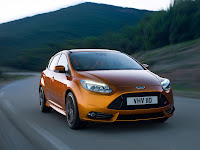
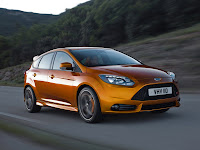
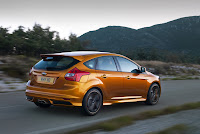
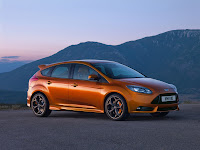

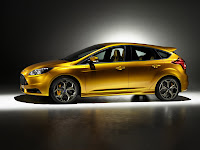
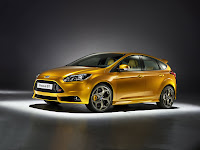

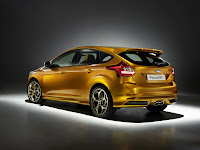
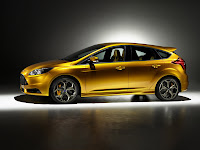
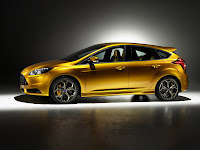
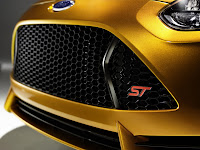

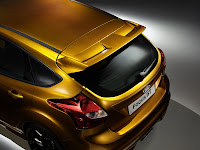
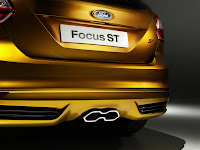

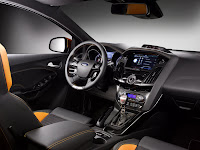
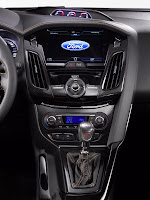

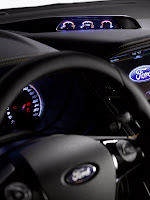
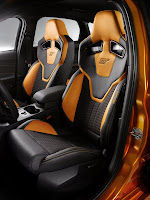
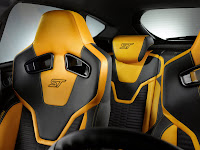
Press Release
GLOBAL REVEAL OF NEW HIGH-PERFORMANCE FORD FOCUS ST AT PARIS SHOW
The next-generation Ford Focus ST makes its global debut at the 2010 Paris Motor Show
Ford delivers on promise to introduce a global performance version of the new Focus: next-generation 250 PS Focus ST previewed at the Paris Motor Show
- Ford's first global high-performance model, scheduled for 2012 launch and developed by Ford's global Performance Vehicles team
- Exciting new model will be true to Ford's ST heritage, with exhilarating performance and handling, an addictive sound and muscular sports design
- Pure performance delivered by unique 250 PS version of new 2.0-litre Ford EcoBoost four-cylinder petrol engine
- Over 10 per cent more power and torque than the current European Focus ST, but fuel consumption and CO2 emissions cut by more than 20 per cent
- Lowered chassis and unique suspension tuning to deliver acclaimed ST handling agility and poise
- 5-door ST show car for Paris features dramatic ‘Tangerine Scream' body colour, reflecting new ST's exciting and energetic character
Ford's first global high performance model and a star attraction for Ford in Paris, the powerful new Focus ST show car was revealed today by Alan Mulally, Ford's President and CEO, and Stephen Odell, Chairman and CEO, Ford of Europe.
This range-topping Focus will be completely true to Ford's ST model heritage, offering driving enthusiasts an intoxicating cocktail of exhilarating performance and handling, an addictive sound and muscular sports design.
"The ST will be the performance flagship of our new Focus range, and we are excited to provide our enthusiast customers with an early preview in Paris," said Gunnar Herrmann, Ford Motor Company's Global C-car Vehicle Line Director. "The ST represents an ultimate expression of Focus driving quality and performance and we are confident that the new model will strengthen the reputation of Ford's ST heritage among enthusiast drivers and attract new fans as well."
Global Performance Model
One common Focus ST model is being developed for all global markets, with the vehicle targeted for launch during 2012. This will be the first time that Ford has produced one of its highly regarded high-performance models for a global audience.
The Focus ST development programme is being undertaken by Ford's global Performance Vehicles group, which comprises Team RS (Europe) and SVT (USA) engineers, who are dedicated to developing and tuning products like the formidable Focus RS, Shelby GT500 and F-150 SVT Raptor.
For new Focus ST the development is being led by Team RS performance specialists based in Europe, building on their extensive experience in engineering sought-after cars like the previous ST models and legendary RS series.
"The new Focus ST will be our first true global performance vehicle and we are excited about the chance to give many customers worldwide their first taste of Ford's acclaimed ST heritage," said Jost Capito, Director of Global Performance Vehicles. "Like the ST and RS models before it, the Focus ST will be the result of painstaking tuning around the curves of the Nürburgring, along high-speed German autobahns, and down classic British B-roads.
"For European drivers, the Focus ST will bring the same distinctive qualities of pure dynamics and performance that have created the unique appeal of our ST heritage.
"For enthusiasts in North America and Asia who have asked why our compact performance models were not available to them - the wait is almost over! The new Focus ST will offer exactly the same exciting driving experience wherever it's on sale," added Capito.
More Performance - and More Economy - from Ford EcoBoost Power
At the heart of the appeal of the next-generation Focus ST is a high-output 250 PS derivative of the efficient and advanced new 2.0-litre Ford EcoBoost four-cylinder petrol engine.
Succeeding the turbocharged 2.5-litre five-cylinder unit of the current European model, this unique 250 PS Ford EcoBoost engine is being specially developed for the new Focus ST to ensure that the car gets the muscular performance - and the inspirational sound - which it deserves. It also marks the first application of the four-cylinder Ford EcoBoost engine in a high performance model.
Compared to the 2.0-litre Ford EcoBoost engine used in other Ford vehicles, the 250 PS unit features re-designed intake and exhaust systems and a unique engine calibration to deliver the desired level of power and responsiveness. The engine retains the strong torque delivery which is a feature of Ford EcoBoost designs, with a broad, flat torque curve offering a maximum output of 360 Nm.
One of a completely new generation of downsized, high-efficiency, low-CO2 petrol engines from Ford, the 2.0-litre Ford EcoBoost is a lightweight, all-aluminium design which combines three technologies - high-pressure direct injection, low-inertia turbocharging and twin independent variable cam timing - to create an advanced combustion system which brings new levels of performance and fuel efficiency to petrol engines in this power range.
This ultra efficient 250 PS engine therefore not only delivers over 10 per cent more power and torque than the current 2.5-litre unit, it is also estimated to reduce fuel consumption and CO2 emissions by more than 20 per cent.
The standard transmission for the Focus ST is a 6-speed manual gearbox, optimised with more sporting ratios carefully matched to the performance characteristics of the engine.
Genuine Performance and Handling
Ford Team RS performance vehicle specialists have a mission: to ensure that the new Focus ST delivers the pure performance and handling everyone expects from a genuine Ford ST model.
Compared to the standard Focus, the ST model will feature a comprehensive range of enhancements including a chassis lowered by 10mm, a substantially different variable ratio steering system, high performance brakes and unique suspension tuning, that will enable the vehicle to deliver the acclaimed ST handling agility and poise.
Naturally, the ST will also benefit from the performance improvements being delivered by the next-generation Focus vehicle architecture. Features like a stronger, stiffer body structure, optimised front and rear suspension system designs, and a new electric power assisted steering (EPAS) system all contribute to superior vehicle dynamics and improved refinement.
Unprecedented Level of Smart Technologies
Focus ST drivers will also be able to take advantage of the unprecedented level of smart new technologies incorporated in Ford's latest global C-car platform, including advanced new driver assistance, powertrain, chassis and active safety features.
Many of these features, such as the advanced new Torque Vectoring Control system - which acts like a torque vectoring differential to enhance cornering stability and agility - have a direct impact on improving driving quality to an even higher level.
"This is the third generation Focus ST and we are determined that the new car will continue the strong heritage of affordable, high performance ST models into the future," said Jost Capito. "The technology on offer with Ford's new global C-car platform will also help to ensure that the Focus ST provides enthusiasts with an exceptional driving experience."
Unique High-Performance Exterior
The new Focus ST features a highly distinctive sports exterior, providing significant functional and aerodynamic benefits and clearly differentiating the ST derivative from other models in the new Focus family.
While sharing the already sleek and dynamic profile of the new Focus five-door, the ST features unique front- and rear-end designs, together with muscular extended rocker panels and striking new alloy wheels based on the classic Y-spoke ST pattern.
"The changes we have made to deliver superior aerodynamics and vehicle performance have made the new Focus ST even more sporty and distinctive," explained Martin Smith, Executive Design Director. "Exciting new design treatments at the front and rear give the ST a much more dynamic and purposeful character, making it very clear that this is definitely a sporting Focus."
The more sporting design language is particularly evident at the front end, where the twin upper and lower grilles of the standard car are replaced by a prominent new one-piece design.
Representing the sportiest definition yet of Ford's signature trapezoidal grille, the bold one-piece design is placed higher on the nose of the vehicle, and incorporates a distinctive hexagonal mesh finished in high gloss black.
The front spoiler has a completely new configuration, with a deep central splitter framed by small motorsport-inspired spoiler blades on either side, which sweep round and encompass the fog lamps. The spoiler blades are linked to the rest of the body lines through the grille structure, which is reminiscent of the similar treatment in the current Focus RS model.
The more assertive, sporting character of the front end is completed by details like the gloss black finish to the headlamp bezels, and the bold red ST badge on the one-piece grille.
From the side, muscular extended rocker panels emphasise the lowered chassis, and the bold wheel arches are filled with 19-inch alloy wheels which are the latest evolution of the classic Y-spoke ST wheel.
Dynamic Rear End Treatment
The rear bumper and lower fascia is also completely new, with prominent diffuser-style vents on either side which mirror the form of the front spoiler blades. Rear lamps with a dark smoked tint enhance the sporty feel.
The new Focus ST has a high-performance exhaust system, which exits the vehicle through a central dual-pipe outlet. The exhaust outlet has been given a highly-distinctive design treatment with a strong kinetic form which emulates the design themes on the rest of the car.
The car's aerodynamic package is completed by a highly effective integrated roof spoiler, which has been optimised to deliver improved high-speed stability and reduced drag. With a larger, more exaggerated design than the spoiler on the current Focus ST, it incorporates ducting to the rear screen and has been carefully integrated with the vehicle tailgate and roof.
Dramatic New Body Colour
The Paris preview car is finished in a dramatic new 'Tangerine Scream' body colour, which reflects the exciting and energetic new character of the Focus ST.
A spiritual successor to the signature Electric Orange finish of the current Focus ST, Tangerine Scream is a very intense and vibrant high-saturation metallic yellow-gold tone created using an experimental process with multiple layers of tinted lacquer.
"Such an exciting new car deserves an exciting new finish and we believe that this vibrant new colour will prove just as memorable as Electric Orange," said Martin Smith. "You can expect to see a very similar shade when the ST reaches the showroom."
To complement the vibrant exterior colour, the 19-inch alloy wheels have a warm, anodised Golden Graphite finish. Their sophisticated five-spoke design is contrasted by the brake calipers which are brightly painted in body colour.
Bold High-Contrast Sports Cockpit
The performance theme from the exterior is echoed inside the car, with a very bold high-contrast sports cockpit featuring Recaro seats, unique instrumentation and modern, highly technical finishes.
Dramatically-bolstered and rally-inspired Recaro leather and fabric front seats provide an ideal balance between sporting support and long-distance comfort, and form the centrepiece of the cabin.
The seats are finished in high-quality Charcoal Black leather, offset by bold orange gold panels in a neoprene fabric and vibrant yellow-gold contrast stitching. The central Charcoal Black fabric seat panels feature a rugged embossed design in the style of a performance tyre tread pattern. The rear Recaro seats are finished in the same distinctive style.
Throughout the cabin, unique details ensure that the Focus ST clearly signals its sporting intent. Three additional gauges for turbo boost, oil pressure and oil temperature are housed in a dedicated binnacle on the upper instrument panel; the instrument cluster features unique ST sports graphics with red needle pointers; and the centre console has a technical carbon-effect finish.
The interior has the signature ST treatment of a dark interior environment, with black headlining, bespoke steering wheel and a gear knob featuring the ST logo, plus metal racing pedals.
The premium sports feel of the cabin is enhanced by a generous use of Charcoal Black leather with vibrant yellow-gold contrast stitching on many of the interior surfaces, including the seats, door panels, central armrest, steering wheel, gearshift gaiter and the top of the instrument binnacle.
"The Focus ST will be a serious driving machine, and we have developed a purposeful exterior combined with a cockpit that blends sporting function with impressive comfort," said Stephen Odell. "The approach of form following function is a key part of the ST DNA, and we have remained true to that both inside and outside the vehicle."
